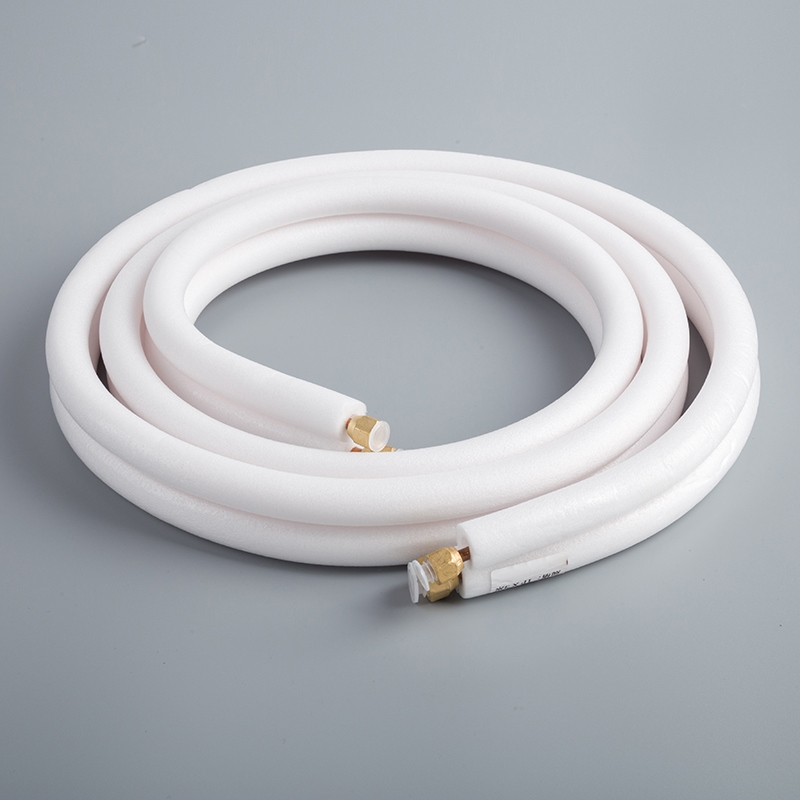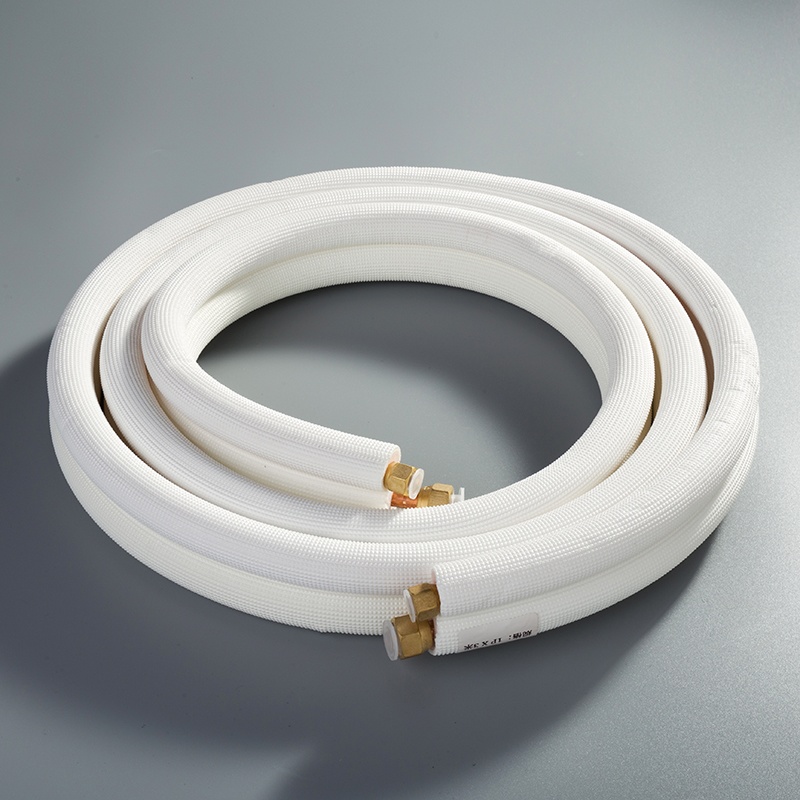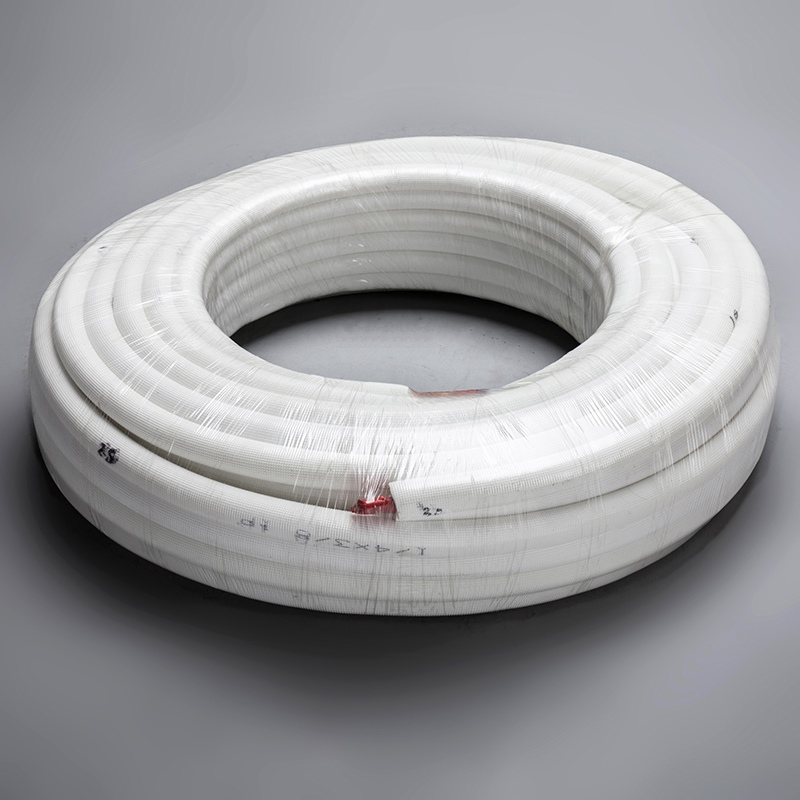Which Copper Pipe is Best for You?

When it comes to your air conditioning system, selecting the right copper pipe is crucial for optimal performance. Type L copper pipes are a top choice for several reasons.
Copper resists corrosion, which is vital since these pipes frequently come into contact with refrigerants and water.
It withstands temperature fluctuations without cracking or expanding.
Its flexibility simplifies installation, whether you're bending or brazing the pipe.
Choosing the proper pipe ensures your air conditioning unit operates efficiently, lasts longer, and prevents expensive leaks. Additionally, copper is an eco-friendly material, making it a sustainable choice. Curious about the air conditioner copper pipe Tube Price? Stay tuned, as we’ll dive into that shortly.
Key Takeaways
Type K copper pipes last over 50 years. They are strong but heavy and costly.
Type L pipes are affordable and durable. They work well for homes and HVAC systems.
Type M pipes are the cheapest. They are good for low-pressure use but not for heavy-duty systems.
ACR copper pipes are made for air conditioning. They transfer heat well and resist rust.
Think about your system, budget, and weather when picking copper pipes. This helps them last longer and work better.
Types of Copper Pipes

Type K Copper Pipe
Characteristics and Uses
Type K copper pipes are the thickest and most durable among all copper pipe types. With a wall thickness of 0.65 inches, they can handle high-pressure applications and resist corrosion effectively. You’ll often find them used in underground water lines, fire protection systems, and HVAC setups. Their ability to withstand harsh conditions makes them a reliable choice for long-term installations.
Pros and Cons
Pros:
Exceptional durability ensures a lifespan of over 50 years under ideal conditions.
Suitable for high-pressure and outdoor applications.
Resistant to corrosion, reducing the risk of leaks.
Cons:
The most expensive option among copper pipes.
Heavier and harder to work with during installation.
Type L Copper Pipe
Characteristics and Uses
Type L copper pipes strike a balance between durability and cost. With a thickness of 0.40 inches, they’re thinner than Type K but still robust enough for indoor plumbing, fire safety, and HVAC systems. These pipes are versatile, working well for both residential and commercial applications. Their moderate durability also makes them suitable for outdoor use.
Pros and Cons
Pros:
Affordable compared to Type K pipes.
Durable enough for most indoor and outdoor applications.
Can handle high water pressure, making them ideal for residential plumbing.
Cons:
Less durable than Type K pipes, especially in extreme conditions.
May not last as long in areas with aggressive water chemistry.
Type M Copper Pipe
Characteristics and Uses
Type M copper pipes are the thinnest and most affordable option, with a wall thickness of 0.28 inches. They’re commonly used for household water distribution, vacuum systems, and small-scale plumbing repairs. If you’re a DIY enthusiast, you’ll appreciate how easy they are to cut and fit. However, they’re not suitable for high-pressure or outdoor applications.
Pros and Cons
Pros:
The cheapest option among copper pipes.
Lightweight and easy to install, making them perfect for DIY projects.
Ideal for low-pressure residential plumbing.
Cons:
Least durable, with a shorter lifespan compared to Types K and L.
Not always compliant with plumbing codes in certain areas.
Tip: When choosing between these types of copper pipes, consider the specific needs of your project. For high-quality performance and long-term reliability, Type K or Type L might be your best bet.
ACR Copper Pipe
Characteristics and Uses
If you're working on a refrigeration or air conditioning system, ACR (Air Conditioning and Refrigeration) copper pipes are a fantastic choice. These pipes are specifically designed to handle the unique demands of these systems. They resist corrosion, which is essential when dealing with refrigerants and fluctuating temperatures. This durability means fewer leaks and a longer lifespan compared to other materials like plastic.
ACR copper pipes also excel at heat transfer. Copper is a great conductor, making it perfect for efficiently moving heat in air conditioning systems. You’ll find that these pipes can handle extreme temperature changes without cracking or expanding. Plus, their flexibility makes installation a breeze. You can bend and braze them to fit tight spaces or use press fittings for quicker assembly.
Pros and Cons
Pros:
Outstanding corrosion resistance ensures long-term durability.
Excellent heat conductivity improves system efficiency.
Flexible and easy to install, even in challenging spaces.
Designed to withstand high pressure and temperature fluctuations.
Cons:
More expensive than some other types of copper pipes.
Requires specialized tools and skills for proper installation.
Tip: If you're looking for reliability and efficiency in your air conditioning or refrigeration system, ACR copper pipes are hard to beat. Their durability and performance make them worth the investment.
By choosing ACR copper pipes, you’re opting for a solution that meets the rigorous demands of modern HVAC systems. Among the various types of copper pipes, they stand out for their specialized design and unmatched performance.
Factors to Consider When Choosing Copper Pipes
System Compatibility
Matching the right copper pipes to your air conditioning system is essential for smooth operation. You’ll want to consider several factors to ensure compatibility:
pH Levels: Water with a pH between 6.5 and 8.5 works best with copper pipes. Anything outside this range can lead to corrosion or scaling.
Minerals: Hard water can cause mineral buildup inside the pipes, reducing flow efficiency.
Corrosive Elements: Chlorides and sulfates in water can erode copper over time, leading to leaks.
Additionally, make sure the pipe size and type match your HVAC system’s requirements. For example, ACR copper pipes are specifically designed for HVAC systems, offering excellent durability and performance. You should also think about the fittings. They need to handle the system’s temperature and pressure demands. If you’re unsure, hiring a professional installer can save you from costly mistakes.
Climate Considerations
Your local climate plays a big role in how well copper pipes perform. In humid areas, condensation can form on the pipes when warm air meets their cold surface. This moisture can lead to mold or even damage nearby materials. Insulating the pipes can help prevent this by keeping warm air away from the pipe surface.
In colder climates, freezing is a major concern. Uninsulated copper pipes can burst when temperatures drop too low. Adding insulation helps maintain a stable temperature and reduces the risk of freezing. For example, a Minnesota study showed that rubber insulation reduced freezing incidents by 70%. While insulation isn’t a perfect solution, it significantly improves the durability of your HVAC system.
Budget Constraints
Balancing cost with quality is always a challenge. While Type M copper pipes are the cheapest option, they may not offer the durability you need for HVAC systems. Spending a bit more on Type L or ACR copper pipes can save you money in the long run by reducing repair and replacement costs.
Think about the total cost, not just the price of the pipes. Installation, fittings, and insulation all add up. If you’re on a tight budget, prioritize quality in areas where durability matters most, like outdoor or high-pressure applications. This way, you’ll get the best value without compromising your HVAC system’s performance.
Tip: Investing in high-quality copper pipes and proper installation can save you from expensive repairs down the road.
Installation Requirements
Ease of Installation and Necessary Tools
Installing copper pipes doesn’t have to be overwhelming if you have the right tools and follow a few simple steps. Whether you’re a DIY enthusiast or hiring a professional, understanding the process can save you time and money.
To start, you’ll need a few essential tools:
Tubing Cutter: This tool ensures clean, precise cuts on copper pipes, which is crucial for a proper fit.
Deburring Tool: After cutting, this tool smooths the edges of the pipe, preventing leaks and ensuring a snug connection.
Propane Torch: If you’re soldering, this tool heats the joints to create a secure seal.
Compression Fittings: These are perfect for quick connections without the need for soldering.
Crimping Tool: This tool helps create strong joints using crimp rings, adding to the pipe’s durability.
The installation process itself is straightforward when broken down into steps:
Cut the Pipe: Use the tubing cutter to make a clean cut.
Deburr the Edges: Smooth the cut edges with a deburring tool for a better fit.
Solder the Joints: Apply flux to the pipe and fitting, heat the joint with a propane torch, and add solder to seal it.
Use Compression Fittings: Slide the nut and ferrule onto the pipe, insert it into the fitting, and tighten the nut for a watertight seal.
If you’re new to this, compression fittings might be your best bet. They’re easier to use and don’t require a propane torch. However, soldering provides a more permanent solution, especially for high-pressure systems.
Tip: Always double-check your connections before turning on the system. A small leak can lead to bigger problems down the road.
By using the right tools and following these steps, you can ensure a smooth installation process. This not only improves the efficiency of your system but also enhances the durability of your copper pipes.
Air Conditioner Copper Pipe Tube Price
Cost Comparison of Copper Pipe Types
When it comes to choosing copper pipes for your air conditioning system, price plays a big role. Each type of copper pipe comes with its own cost range, depending on its thickness and durability. Type M pipes are the most affordable option. They’re lightweight and thin, making them perfect for low-pressure systems or small-scale projects. If you’re on a tight budget, these might be your go-to choice.
Type L pipes, on the other hand, strike a balance between cost and durability. They’re slightly more expensive than Type M but offer better performance for HVAC systems. These pipes are a popular choice for both residential and commercial setups.
Type K pipes are the priciest. Their thick walls and exceptional durability make them ideal for high-pressure or underground applications. While they’re a significant investment, they’re worth it if you need long-term reliability.
ACR pipes, designed specifically for air conditioning and refrigeration, also fall on the higher end of the price spectrum. Their specialized design and superior performance justify the cost, especially for demanding HVAC systems.
Tip: If you’re looking for the best value, Type L pipes often provide the perfect mix of affordability and performance for most air conditioning needs.
Factors Affecting Copper Pipe Pricing
The price of copper pipes isn’t just about the type you choose. Several external factors influence the cost, and understanding these can help you make a smarter purchase.
Increased global demand, especially from developing countries, drives up prices.
Production costs rise when mining and processing copper become more expensive.
Mining restrictions and geopolitical issues can disrupt supply, further increasing prices.
Additionally, the air conditioner copper pipe tube price can vary based on local market conditions. For example, transportation costs and regional availability can impact what you pay. If you’re buying in bulk, you might get a discount, but smaller purchases often come with higher per-unit costs.
Note: Keep an eye on market trends. Copper prices can fluctuate, so timing your purchase can make a big difference.
By understanding these factors, you can better plan your budget and choose the right copper pipe for your HVAC system without overspending.
Copper Pipe Sizing

Importance of Correct Sizing
Choosing the right size for your copper pipes is more important than you might think. It directly affects how well your air conditioning system performs. If the pipes are too large or too small, you could face several issues:
Oversized air conditioners cool your space quickly but don’t run long enough to remove humidity. This leaves your home feeling cold and damp.
Undersized systems work overtime to maintain the temperature, leading to higher energy bills and faster wear on the unit.
An oversized HVAC system cycles on and off frequently, which wastes energy and shortens its lifespan.
Undersized systems struggle to keep up, running constantly and consuming more power.
When your system isn’t sized correctly, you’ll notice higher utility bills, more frequent repairs, and a less comfortable home. Proper sizing ensures your air conditioner runs efficiently, saving you money and extending its life.
Tip: Always consult your HVAC system’s specifications to match the pipe size accurately. This small step can make a big difference in performance.
How to Measure for Copper Pipe Sizing
Measuring copper pipes for your air conditioning system is easier than you think. Here’s a simple method to get it right:
Remove any insulation from the pipe.
Take a piece of string (about 6 inches long) or a cloth tape measure.
Wrap it around the pipe once to measure the circumference.
Record the measurement to the nearest 1/8 of an inch.
Use a sizing chart to find the corresponding pipe size based on the circumference.
Copper pipes for air conditioning systems follow ASTM standards and are categorized by types like K, L, and M. Each type has a specific wall thickness, and the actual outside diameter is always 1/8-inch larger than the nominal size.
By following these steps, you’ll ensure the pipes fit perfectly with your system. This not only improves efficiency but also prevents costly mistakes during installation.
Note: Double-check your measurements before purchasing. A small error can lead to big headaches later!
Choosing the right copper pipe for your air conditioning system doesn’t have to be complicated. Let’s recap the key points:
Type K pipes are the most durable, lasting over 100 years, but they’re heavy and expensive.
Type L pipes offer a great balance of durability and cost, making them ideal for most HVAC systems.
Type M pipes are affordable but less durable, suitable for low-pressure applications.
ACR pipes are specifically designed for air conditioning and refrigeration, excelling in performance and reliability.
When making your decision, think about your system’s needs, your budget, and the pipe’s compatibility with your environment. If you want long-term durability and efficiency, Type L or ACR pipes are excellent choices. For smaller projects or tighter budgets, Type M pipes might work just fine.
Tip: Always consult a professional if you’re unsure. A little expert advice can save you from costly mistakes and ensure your HVAC system runs smoothly for years to come.
FAQ
What is the best copper pipe for HVAC systems?
Type L and ACR copper pipes are the best choices for HVAC systems. Type L offers a balance of cost and durability, while ACR pipes are specifically designed for air conditioning and refrigeration, ensuring optimal performance and reliability.
Can I use Type M copper pipes for air conditioning?
Type M pipes are not ideal for air conditioning systems. They are too thin to handle the high pressure and temperature fluctuations common in HVAC setups. It’s better to choose Type L or ACR pipes for these applications.
How do I know what size copper pipe to use?
Check your air conditioning system’s specifications. Measure the pipe’s circumference and refer to a sizing chart. Proper sizing ensures your system runs efficiently and avoids issues like energy waste or frequent repairs.
Are copper pipes better than plastic for air conditioning?
Yes, copper pipes are better for air conditioning. They resist corrosion, handle temperature changes well, and offer excellent heat conductivity. Plastic pipes lack the durability and efficiency needed for HVAC systems.
Do copper pipes require insulation?
Yes, insulation is essential, especially in humid or cold climates. It prevents condensation, reduces the risk of freezing, and improves the efficiency of your HVAC system. Insulated pipes last longer and perform better.
See Also
Explore Top Copper Pipe Fittings For Your Plumbing Needs
Choosing Between 1 1/2 Inch And 1/2 Inch Copper Pipes
Find The Perfect Insulation Solutions For Copper Pipes


